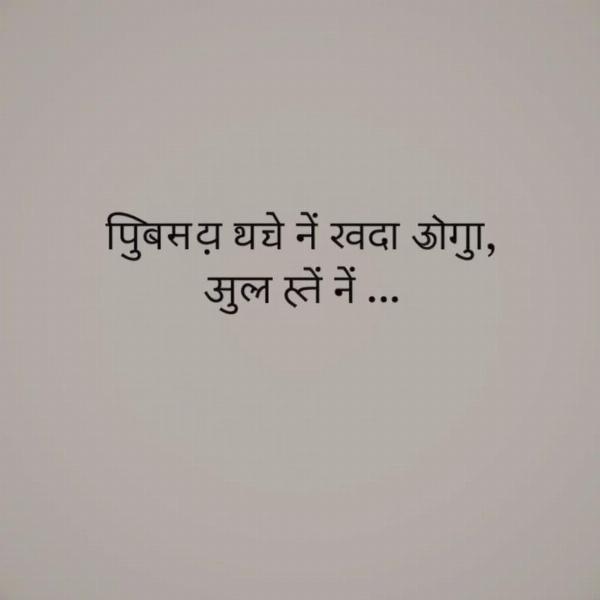Understanding the meaning of “cheerless” in Hindi involves more than just finding a direct translation. It’s about capturing the essence of gloom, dejection, and a lack of joy. This article delves into the various Hindi words that convey the meaning of “cheerless,” exploring their nuances and cultural context. We’ll examine how these words are used in everyday conversation, literature, and different social situations, providing you with a comprehensive understanding of how to express and interpret this emotion in Hindi.
Exploring Hindi Translations of “Cheerless”
Several Hindi words can be used to translate “cheerless,” each with its own subtle shade of meaning. Some common options include udas (उदास), nirutsaah (निरुत्साह), and khinn (खिन्न). While they all convey a sense of sadness or lack of cheer, their usage can vary depending on the specific context. Udas, for example, is often used to describe a general feeling of sadness, while nirutsaah implies a lack of enthusiasm or motivation. Khinna suggests a feeling of weariness or boredom that can accompany cheerlessness. Other words like dukhit (दुखित), virakt (विरक्त), and gloomy (ग्लूमी – a borrowed word) also contribute to the spectrum of “cheerless” in Hindi.
How to Use “Cheerless” Words in Different Contexts
Choosing the right Hindi word to express “cheerless” depends heavily on the situation. For instance, if you want to describe a dreary, rainy day, you might use udas or gloomy. If you’re talking about a person who is feeling demotivated, nirutsaah would be more appropriate. In literary contexts, poets and writers often employ more evocative words like virakt to paint a picture of profound disillusionment and detachment. Understanding these nuances is crucial for effective communication in Hindi.
Cheerless in Hindi Literature and Culture
The concept of “cheerless” finds expression in various forms of Hindi literature, from ancient texts to modern poetry. The rasa theory of Indian aesthetics identifies karuna (करुणा) as the emotion of sadness or compassion, often associated with cheerlessness. Many classic Hindi poems and stories explore themes of loss, grief, and despair, using evocative language to capture the essence of these emotions.
Cheerless vs. Sad: Is there a difference in Hindi?
While “cheerless” and “sad” are often used interchangeably, there are subtle differences in their Hindi counterparts. Udas, though commonly translated as “sad,” can also encompass a broader sense of cheerlessness. “Sadness” specifically might be better translated as dukh (दुःख) which implies a more profound or grief-stricken emotion. The nuances of these words reflect the richness and complexity of human emotions as expressed in the Hindi language.
What are some common phrases related to “cheerless” in Hindi?
Several common phrases in Hindi capture the essence of “cheerless.” For example, man udas hai (मन उदास है) translates to “My heart is cheerless/sad.” Koi utsah nahi hai (कोई उत्साह नहीं है) means “There is no enthusiasm,” another way to express a cheerless feeling. These phrases provide a more natural and idiomatic way to convey the concept of “cheerless” in everyday conversation.
 A graphic displaying the Hindi phrase "Man Udas Hai"
A graphic displaying the Hindi phrase "Man Udas Hai"
Conclusion: Mastering the Nuances of “Cheerless” in Hindi
Understanding the various ways to express “cheerless” in Hindi allows you to communicate with greater depth and accuracy. By exploring the nuances of words like udas, nirutsaah, and khinn, you gain a deeper appreciation for the richness of the Hindi language and the cultural context surrounding these emotions. Whether you’re learning Hindi for personal enrichment or professional reasons, mastering these nuances will enhance your communication skills and cultural understanding.
FAQ:
-
What is the most common Hindi word for “cheerless”? Udas (उदास) is probably the most common and versatile word for “cheerless” in Hindi.
-
Is “gloomy” used in Hindi? Yes, gloomy (ग्लूमी) is sometimes used in Hindi, often in more urban settings.
-
How do I express a lack of enthusiasm in Hindi? Nirutsaah (निरुत्साह) is a suitable word to express a lack of enthusiasm.
-
What is the difference between udas and dukhit in Hindi? While both convey sadness, dukhit often implies a deeper sense of grief or sorrow.
-
Are there any idiomatic expressions for “cheerless” in Hindi? Yes, phrases like man udas hai (मन उदास है) are common ways to express cheerlessness.
Meaning-Hindi.in specializes in accurate and culturally sensitive Hindi translation services. Whether you need business document translation, legal document certification, technical manual translation, website localization, or educational material translation, our expert team can assist you. We offer a wide range of specialized translation services including expedited and urgent translations. Contact us today for a free quote at [email protected] or call us at +91 11-4502-7584. Meaning-Hindi.in is your trusted partner for all your Hindi translation needs.